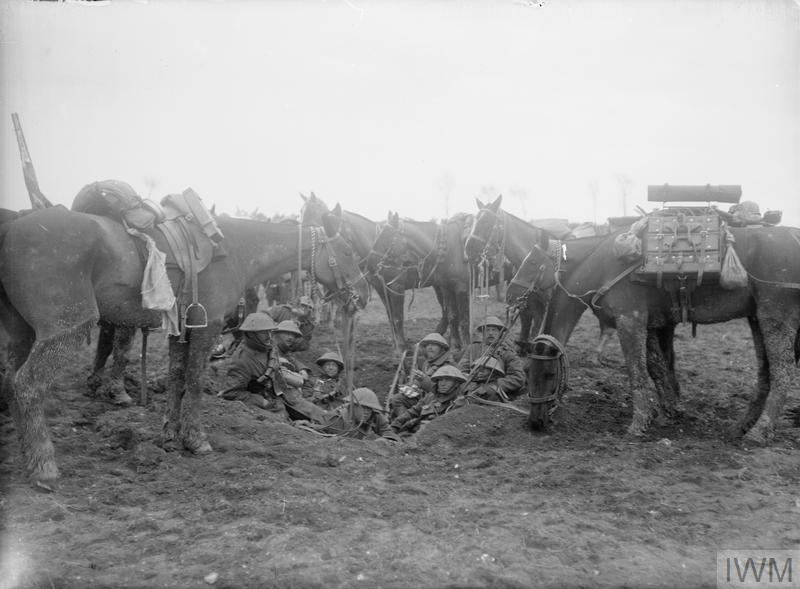Albert, 1918
Fierce fighting took place around Albert from the earliest days of the war, in September 1914. Albert was a major control centre for the planning of the Somme battle. However, by the close of that battle in the autumn of 1916 the town itself had largely been reduced to a pile of rubble. Albert remained in allied hands right up until the great German push of Spring 1918, when it was taken on 26th March. It was recaptured by the British on 22nd August, just under five months later.
The Honour is borne on the Guidon of the 8th Hussars.
Detail
On the dull muggy day of the 20th, the 8th Hussars remained in bivouac at Thievres, not moving from it till 11.30 pm, when it marched to a new concentration point on the 21st at 3 am, the first day of the Battle of Albert, which lasted to the 23rd of August.
With the 3rd Army, Sir Julian Byng struck on the 21st, and he struck with all his might at the Battle of Albert. His objective was the recovery of the Arras-Albert railway.
On a front of nine miles between Moyenneville and Beaucourt, it broke through the German front on the first rush. Beaucourt, Achiet-Ie-Petit, Courcelles, and Moyenneville were all taken.
The next day the left-wing of Rawlinson’s 4th Army came into action between Albert and the Somme and scored another success. Albert and Meaulte were recovered.
The Germans were now in retreat on a wide front, and the Battle of Bapaume came to confuse and to cripple their withdrawal. The outcome of this battle was that Ludendorff could find no, resting place for his men short of the main Siegfried line.
Active fighting was not to be the share of the 8th Hussars in the Battle of Albert. Its concentration point on the morning of the 21st of August was in a valley three-quarters of a mile east of Essarts-Les-Bucquoy.
Arriving there at 8.30 am it waited there in reserve the whole day saddled up. It moved out of the valley at 6.30 pm, arriving in bivouac at Amplier at 9 pm. The morning was very foggy, and this lasted to about 10 am. Then the heat was excessive and there was no shade anywhere. The Commanding Officer was at Brigade Headquarters all day, while the regiment was behind the battery.
Lieutenant Rowle acted as liaison with the 2nd Cavalry Brigade, working to the north of us with the 6th Corps. The Regiment was, however, working under the 4th Corps. On the terrifically hot day of the 21st, the Eighth remained in bivouac at Amplier. It remained standing to at an hour-and-a half’s notice from 6.30 am on the 22nd and 23rd. It moved from Amplier at 7.30 pm on the 23rd, marching via Arieux, Sarton, Toutencourt, to Contay, where it arrived at 10 pm.
On arrival, the regiment received orders that it should be required to operate with the 5th Corps at daylight. The Adjutant set out for the 5th Corps Headquarters for orders. Subsequently, they marched towards Albert.
The advanced squadron was ‘A’, under Captain Crurnes. The remainder of the regiment halted southwest of Albert till 6.15 am, and then moved forward, getting clear of Albert by 7. At this hour a mist hung over the valley. The regiment halted clear of the Bapaume-Albert road a mile northeast of Albert till 8 am. In the meantime, the squadron had pushed patrols to Maison in order to get into touch with the infantry there.
Reports at 6.30 am on the 25th showed that the line now ran from Bazentin-le-Grand to the northwest. The Germans were in force in the high wood, and the infantry reported the like of the edge of Mametz Wood. At 8 am the line from Eaucourt l’Abbe to the high wood was still stoutly held by the Germans.
Patrols were sent out towards the high wood, and they found the ground impassable for the cavalry to move off the roads. There was a certain amount of shelling, but they lost only two horses. At 6 pm orders were received to withdraw and report to the 9th Brigade, and were relieved by the Carbineers.
‘B’ and ‘C’ squadrons moved back to Albert at once and watered. ‘A’ Squadron was recalled and joined an hour later. As there was only one bridge available at Albert, the traffic was blocked for miles. ‘A’ Squadron was clear of Albert by 8 p.m., but the congestion of the traffic destroyed all chance of watering. The regiment halted on the main Doullens road west of Bouzincourt and fed. A very heavy thunderstorm broke at 9 pm, and weighty rain continued all night. They continued to march via Acheux and Sarton to bivouac at Amplier, where both the men and horses arrived in a very tired condition.


